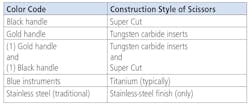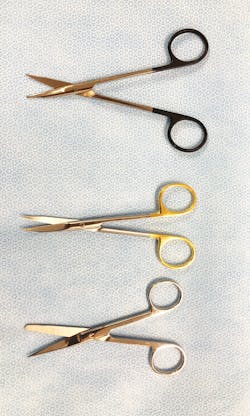Quality Assurance vs. Quality Improvement; types of scissors
Q
Can you explain the difference between Quality Assurance (QA) and Quality Improvement (QI)?
A
Quality Assurance (QA) measures compliance against certain required standards. Quality Improvement (QI), on the other hand, requires and normally focuses on individuals, while QI is a proactive approach to improve processes and systems. Standards and measures developed for QA can inform the QI process. To me, they go hand-in-hand, and you need to be doing both in any medical device reprocessing department.
Here are real-life examples depicting either as QA or QI focus:
• How do we reduce trays errors in our prep and pack/assembly process? This is a QI process.
• A patient had a bad outcome. Is it a nursing, a physician or some other process at fault? This would be a QA process.
My view is an active QI is very helpful in improving how your department works. It helps you understand your department better and finds new ways to do things, provides a great opportunity for every department to improve, and improvement leads to better patient outcomes.
I also believe that implementation of any quality improvement or risk-based program does not always prevent incidents from happening, but they will help you reduce and understand those incidences better if they do occur.
Q
I heard the term used “super sharp scissors” recently in a webinar. What type of scissors are these? I do not think we have that kind in my department.
A
Here is a direct quote from one of the instrument manufactures. “A unique blade design - combining a razor edge with a scissor edge, these scissors produce a clean, forward cut, eliminating pinching or slipping of tissue.” (Scanlon, 2015) Sometimes a Super Cut is also called a Super Sharp.
Now let me expand on that statement.
Scissors come in two designs in my view (i.e., spring loaded and ring hand type). Within these design features, there are distinct identifiers to help the surgeons, OR personnel and the medical device reprocessing professionals to know the type of scissor blade they have and how to use it in their procedure.
You can typically recognize the construction style of scissors based on the following color code:
As noted by the table and seen in the picture (below), once you know the color coding it is easy to identify the correct type of scissor that can be requested by a surgical team member.
Scissor tips may be straight, curved, angled or bent.
As you can see by the picture, once you know the color coding it is easy to identify the correct type of scissor sharpness that can be requested by a surgical team member.
Reference:
1. HHS, U. S. Dept., & HRSA. (2011, April). QUALITY IMPROVEMENT. https://www.hrsa.gov. https://www.hrsa.gov/sites/default/files/quality/toolbox/508pdfs/qualityimprovement.pdf.
2. Green D. K. (1991). Quality improvement versus quality assurance?. Topics in health record management, 11(3), 58–70. https://pubmed.ncbi.nlm.nih.gov/10110014/.
3. International Inc, Scanlan. (2015). The Original Super CutTM & Ultra Sharp® Scissors Collection: The Finest Surgical Scissors. https://www.scanlaninternational.com/. https://www.scanlaninternational.com/wp-content/uploads/2015/12/SuperCut-Scissors.pdf.
About the Author

Stephen M. Kovach
Stephen M Kovach, BS, CFER, started in the medical field in 1975 as a sterilization orderly and has worked in many positions within the Healthcare Industry. He presently is Clinical Educator Emeritus at Healthmark, A Getinge company.


